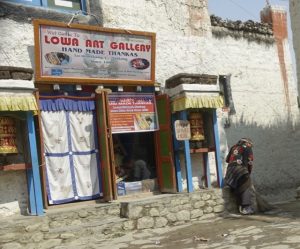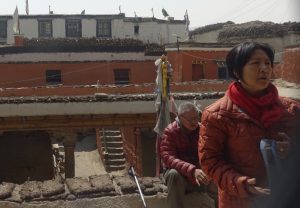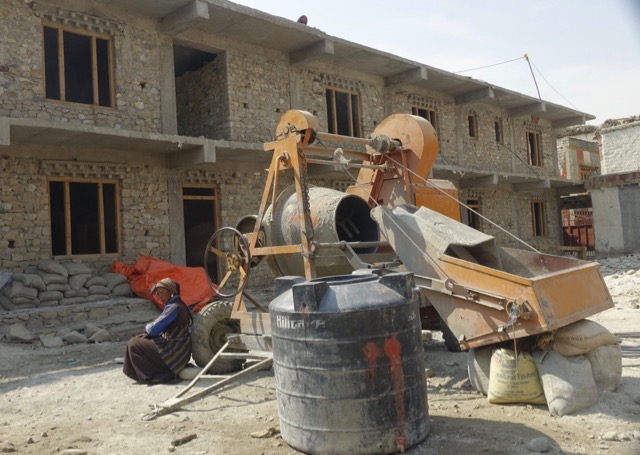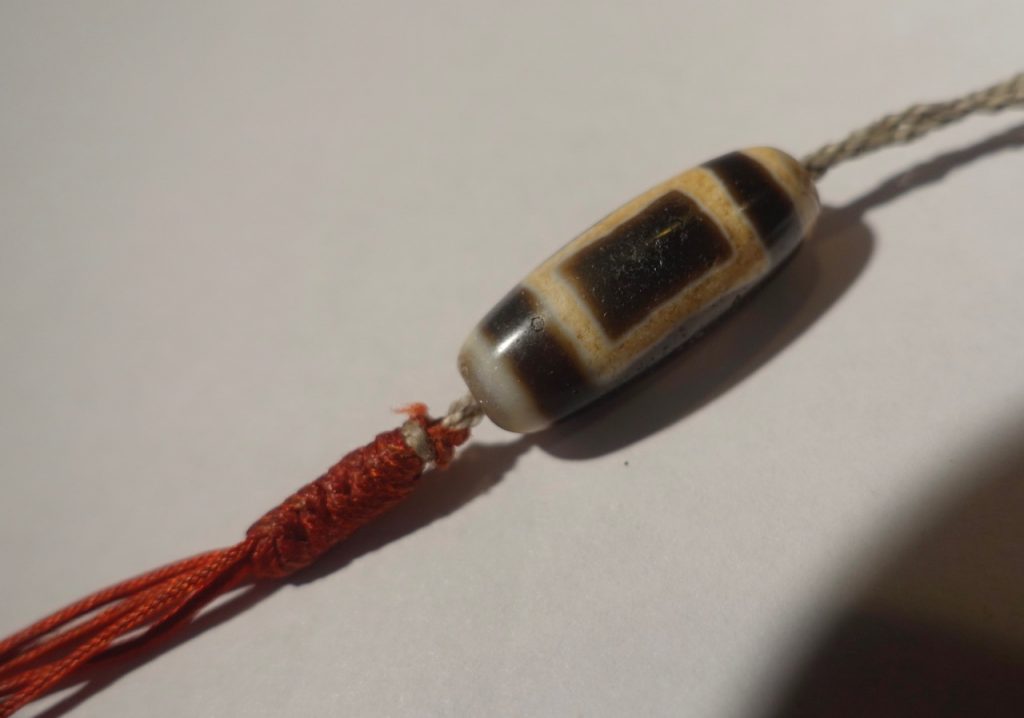In 1972, the United Nations Educational, Scientific, and Cultural Organization (UNESCO) began a campaign to “protect the world’s cultural and natural heritage”, through the designation of World Heritage Sites. About 1,000 such sites exist now. In my part of the world, the western US, these include: Olympic, Redwood, Yosemite, Grand Canyon, Yellowstone, and Glacier National Parks; and Mesa Verde, Chaco Canyon, and Taos Pueblo indigenous sites.
The 175 signatories to the Convention establishing this program also list 1750 sites suggested for inclusion. In Nepal, there are 15; one of these is the medieval earthen walled city of Lo Manthang. Reasons for inclusion are the collection of chortens, mani walls, stone and earth dwellings, and the continuing language, culture, and religion of western and central Tibet. A close analogy would be the Taos Pueblo complex, where people have lived continuously for over 1000 years in the multi-storied adobe village.
Tuesday morning, we were set to tour the several monasteries within the walls of Lo. We met our guide by the mani wall in the plaza outside the largest monastery. He introduced himself in hesitant, accented, but perfect English. Like most of the locals, he was dressed for the cool weather in blue jeans, a western plaid shirt, and a puffy fake down jacket. His dark hair was a bit unkempt, and he had a scraggly beard of uncertain age. Just below his welcoming smile, around his neck, he word a small stone threaded lengthwise through some braided nylon string, with a short red tail at the bottom.
“What’s that around your neck?” Cheryl asked. “It looks like a Dzi.”
He nodded. “Yes.” He smiled sheepishly. “I find it outside, in the fields, last year during planting. I don’t know how long it was there. I don’t know if it’s real, but I like it, so I wear it for its power.”
Dzi stones are small decorative agates, usually mixing dark brown and white segments. They feature one or more (up to 9) “eyes”, which are the shape made by the white part of the agate. They have been ground, rounded, and polished, and are almost always cylindrical or ovoid (like an American football) in shape, maybe two centimeters or so in length, less than one in diameter. There is a central hole for the thread.
“Real” Dzi stones are often hundreds of years old, passed down through generations. Venerated for their power unique to the shape and character of the eye, they bestow fortune and promise to the wearer by interacting with his own aura, providing hope in various areas of the human travail: marriage, agriculture, children, spirit – all are enhanced by the proper stone.
Over the centuries, a real Dzi stone will develop distinct but subtle signs of age and wear. The thread hole will become worn at one spot, where the string has rubbed. The agate surface will develop cracks from microscopic particles of water freezing and thawing over time in the harsh climate. Tiny red to dark brown spots of literal rust from the iron within the stone may appear. If all these are present, there are many eyes, and the pattern is especially propitious, Dzi stones can fetch enormous sums – $100,000 or more – from collectors. We had seen a few Dzi in the “Uriah Heep” store the previous day, going for $250. But we knew nothing of how to tell their value.
 Before we entered the first monastery, our guide gave us a bit of his background. Second-born, he entered this very monastery as a young monk at age 9. By the time he was 19, he was traveling all over Nepal and even to Tibet, visiting other gompas. Finally, at 26, he realised he wanted to be in the world. In Kathmandu, taking a nine month course in mural restoration to help repair the old wall drawings in his home gompa, he met another student, a girl, and fell in love. Knowing that wouldn’t sit well with the lamas back home, he quit the order, started work on cleaning and repainting the walls he had stared at while trying to read the ancient religious texts. He began giving tours of Lo, and eventually opened his own shop where he sold exquisite reproductions of the intricate paintings found on so many Buddhist chapel walls.
Before we entered the first monastery, our guide gave us a bit of his background. Second-born, he entered this very monastery as a young monk at age 9. By the time he was 19, he was traveling all over Nepal and even to Tibet, visiting other gompas. Finally, at 26, he realised he wanted to be in the world. In Kathmandu, taking a nine month course in mural restoration to help repair the old wall drawings in his home gompa, he met another student, a girl, and fell in love. Knowing that wouldn’t sit well with the lamas back home, he quit the order, started work on cleaning and repainting the walls he had stared at while trying to read the ancient religious texts. He began giving tours of Lo, and eventually opened his own shop where he sold exquisite reproductions of the intricate paintings found on so many Buddhist chapel walls.
Following us into each of the sites were a threesome, about our age. Two ladies and an older man, all Himalayan in appearance. One of the women seemed to be the leader, or at least the most assertive. Eye-catching in her bright red outfit, she was speaking English in a pastiche of accents: Canadian, English (Southeast/London) and Nepali/Indian.
Since we seemed on the same path, we started a small conversation. Cheryl asked what they were doing.
“We are here with my brother, so he can see these places before he goes.”
“Where are you from – I hear Canada, India, and England in your voice,” I ventured.
She smiled. “Yes it is funny, where I’m from. I was born in Tibet, but in 1959, fled with he Dalai Lama to Dharamsala. From there, I went to college in London, then got a doctorate in Asian studies at Oxford. I finally moved to Toronto, where we live now.”
“You are here on a pilgrimage of sorts …?”
“Yes. It is important to see these places, and it is so hard for someone like me to get to them in China now. And why are you here?”
I told her my story of reading Heinrich Harrar, longing to see the Tibet he traveled through in 1942/3, drink rancid yak-butter tea and eat Tsampa, and hear monks chanting and gongs clanging with the single note long-horns.
“Now that Tibet is gone, I learn. Tibetan Buddhism, and its view of the world and how people should live together, is a treasure for us all. I think it is important for the world that it not just be allowed to disappear. So I am here, I’ve discovered, to honor that, and do my part to keep these people here, in their ways, and then take that story back out into the world.”
“Yes, I can understand that. Our hearts were broken, of course, when we had to leave. And it has only gotten worse since. Mustang is a place where the Tibet that was, still is, and I do hope the modern world coming in, the electric wires and cell phones and internet, do not change the things that are underneath.”
“I’m worried about what could happen when the current Dalai Lama dies. It is scary what the Chinese might do.”
“Yes, we worry about that, too.” She smile wanly, with downturned eyes, no humor there.
 Outside the gompa, in the courtyard where the monks lived, the contrasts persisted. A traditionally dressed local woman sat in front of a churning cement mixer. Instead of wet mud, they were now using modern building materials along with the river stones for the growing dormitories. Around the corner, teen-age monks in red robes were practicing for the dance they would perform at the Tiji festival next week. Some had red Nike sneakers on, others had red sweatshirts with random English words emblazoned. One daring boy wore a red ball cap which had “Oh, Shit” across the top. They all smiled and tried to keep in time with the choreographer.
Outside the gompa, in the courtyard where the monks lived, the contrasts persisted. A traditionally dressed local woman sat in front of a churning cement mixer. Instead of wet mud, they were now using modern building materials along with the river stones for the growing dormitories. Around the corner, teen-age monks in red robes were practicing for the dance they would perform at the Tiji festival next week. Some had red Nike sneakers on, others had red sweatshirts with random English words emblazoned. One daring boy wore a red ball cap which had “Oh, Shit” across the top. They all smiled and tried to keep in time with the choreographer.
As we moved towards the gompa housing the giant Buddha, I asked the Canadian/Tibetan pilgrim about our guide’s Dzi stone, which he had given us to appraise. She looked at it very carefully, turning it over multiple times.
“I am not an expert. I can’t tell you if this is a true Dzi stone or not. It does have some characteristics of an original, but others are not in keeping. But what is more important is how it makes you feel. If you feel a connection with it, that is what is more important than the age or depth of its water marks. Especially if there is a story you have with this one, like the guide has told you.”
I thought of our conversation, about the need to keep Lo Manthang vivid as a living place where the Tibetan ways and thought were active and evolving, out of reach of the Chinese thumb. If giving $200 could help a man struggling to make a family and a life here, restoring the monastery, that was one way I could support the real purpose of my Tibetan pilgrimage.

